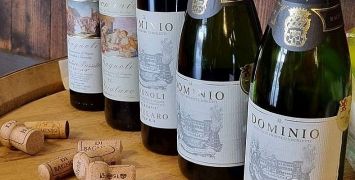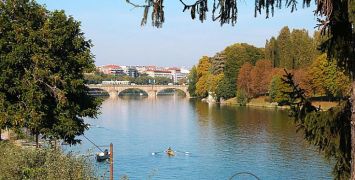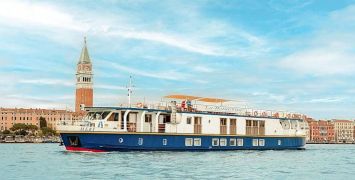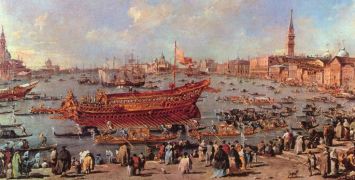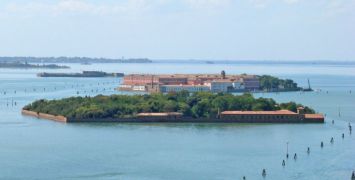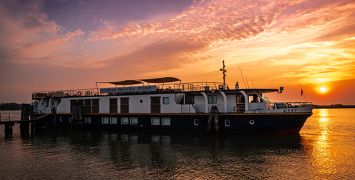Video: Tour of Ferrara including the Castello Estense
During our cruise aboard La Bella Vita we tour of the Renaissance city of Ferrara, including the 14thC Estense Castle with its moat, drawbridges, marble balconies and sumptuous apartments, and the Schifanoia Palace with its fabulous 15thC frescoes. We also see the cathedral façade with its sculpted images described as an Illustrated Bible.
Ferrara, which grew up around a ford over the River Po, has a rich cultural heritage with renowned artists, writers, musicians and scientists all leaving their mark. In the 15th and 16th centuries Ferrara became an intellectual and artistic centre that attracted the greatest minds of the Italian Renaissance. One of Ferrara’s most famous university graduates is Nicolaus Copernicus (1503).
The town has broad streets and numerous palaces dating from the 14th and 15th century when it hosted the court of the House of Este. The town is still surrounded by more than 5 miles of ancient walls, mainly built in the 15th and 16th centuries. Together with those of Lucca, they are the best preserved Renaissance walls in Italy.
The origin of Ferrara is uncertain. It was probably settled by the inhabitants of the lagoons at the mouth of the Po River. Ferrara first appears in a document of 753 AD.
The House of Este settled in Ferrara in the 12th century and for four centuries Ferrara was the uninterrupted seat of the d’Este court. During the reign of Ercole d’Este I, one of the most significant patrons of the arts in late 15th and early 16th century Italy, Ferrara grew into a cultural centre, renowned for music as well as for visual arts. Alfonso I, son of Ercole, was also an important patron. His preference for instrumental music resulted in Ferrara becoming an important centre of composition for the lute. Alfonso married the notorious Lucrezia Borgia.
The architecture of Ferrara benefited from the genius of Biagio Rossetti who, in 1484, was asked by Ercole I to redesign the plan of the city. The resulting Addizione Erculea is one of the most important and beautiful examples of renaissance city planning and contributed to the selection of Ferrara as a UNESCO World Heritage Site.
REGIONAL SIGHTS
The most iconic building of the town is the ancient ducal fortress Castello Estense. Sited in the very center of the town, it’s a brick building surrounded by a moat, with four massive bastions. It was built starting in 1385 and partly restored in 1554 with the addition of pavilions on the top of the towers. The fortress, with its drawbridges and unusual battlements, also houses marble balconies and sumptuous apartments.
The ancient City Hall, renovated in the 18th century, was the earlier residence of the Este family. The former Cathedral of Saint George was begun in 1135 when the Romanesque lower part of the main façade and the side façades were completed. The upper part of the main façade, with arcades of pointed arches and the elaborate relief sculptures depicting the Last Judgement, date from the 13th century. The campanile, in the Renaissance style, dates from 1451-1493, but the last story was added at the end of the 16th century. The interior was restored in the Baroque style in 1712.
Ferrara has many early Renaissance palaces. Among the finest palaces is Palazzo dei Diamanti, named after the diamond points into which the façade’s stone blocks are cut. The palazzo houses the National Picture Gallery with a large collection of the school of Ferrara. The Casa Romei is the best preserved Renaissance building in Ferrara. It was the residence of Giovanni Romei, related to Este family by marriage. It did not fall into decay because it was inherited by the nuns of the Corpus Domini order who lived there without making any changes to its structure. Much of the
decoration in the inner rooms has been saved. The Corpus Domini Monastery contains tombs of the House of Este.
Related Articles
Italian Cruises: A Guide to Our Sensational River Cruises
Thinking of taking one of our river cruises in Italy? One of our top destinations and this short video shows you why guests love it so much! Read More
Discover the Delights of Italian Cheese: A Comprehensive Guide
Italy produces approximately 600 different types of cheeses, and some of their most famous cheeses date back centuries, or even millennia years in the case of Pecorino Romano Read More
Italian Wine Guide: Everything You Need to Know
Guide to Italian wines including wine regions, categories, classifications, how to read the label and more! Read More
The Ultimate Guide to Cruising the Po River in Italy
Italy’s longest river, the River Po flows through many important cities through its 562km course, including Turin, Piacenza, Cremona and Ferrara. Read More
Italy Cruises: Everything You Need to Know
A river cruise in Italy with European Waterways is a fantastic introduction to this wonderful country, with something for every kind of traveller. Read More
The History of Venice: Italy’s Historic ‘Floating City’
The Venetian Lagoon is an ambiguous area that is neither land nor sea. Stretching some 34 miles in length and 7 miles wide, it takes a crescent shape along... Read More
The Ultimate Guide to Cruising the Venetian Lagoon and its Islands
The Venetian Lagoon is an ambiguous area that is neither land nor sea. Stretching some 34 miles in length and 7 miles wide, it takes a crescent shape along... Read More
Torta Caprese Delicious Italian Chocolate Cake Recipe
This Italian chocolate cake is easy to make and just as easily devoured! Originating from Capri, torta caprese is known for its cocoa and almond flavour. Read More
Memories from a Beautiful Life aboard La Bella Vita
Travel writer, photographer and avid 'quilter' Rose Palmer-Sungail shares her memories aboard hotel barge La Bella Vita... Read More
 English
English
 Spanish
Spanish French
French German
German Norwegian
Norwegian Portuguese
Portuguese Swedish
Swedish Italian
Italian Russian
Russian Simplified Chinese
Simplified Chinese Japanese
Japanese


